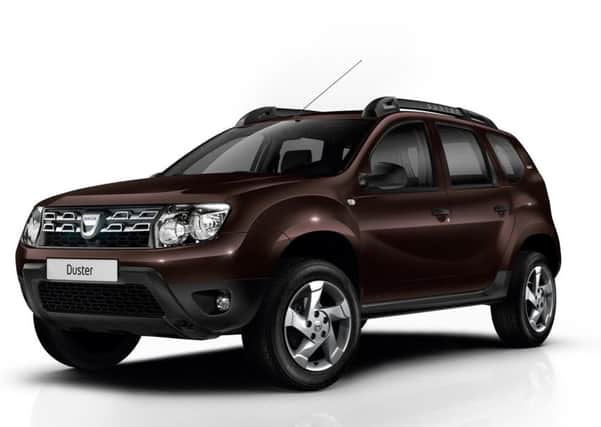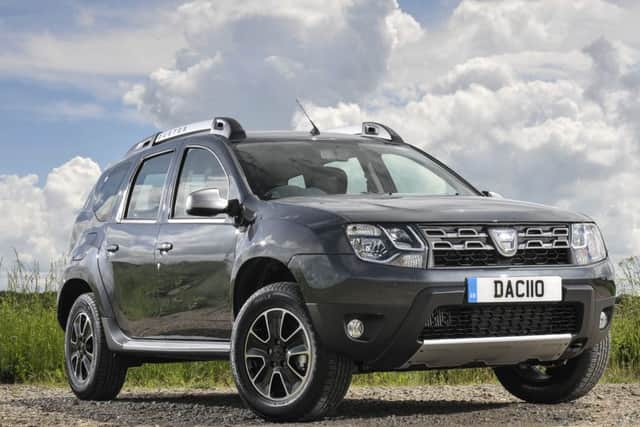Easy to see why the Dacia Duster is cleaning up


Two months into our long-term test of the Dacia Duster we can see why the budget brand are winning fans. Dacia’s combination of back-to-basics equipment levels, practicality and knock-down pricing has helped the Renault-owned firm establish a sizable foothold in the UK market and 78,000 cars have been sold in Blighty since Dacia first crossed the channel in 2013.
Dacia’s timing couldn’t have been better. With SUVs and crossovers deposing three-box saloons as kings of the road in the UK — and formerly bottom-end-of-the-market brands like Kia and Hyundai repositioning themselves further upscale — in came the Romanians with an SUV you can buy new for under ten grand.
Our test car is an Ambiance Prime DCi 110, costing £12,495.


Advertisement
Hide AdAdvertisement
Hide AdDriving a Dacia is like stepping back in time 15 years in terms of standard equipment and it’s a reminder of just how much of what you pay for in most modern cars is actually non-essential to the core purpose of a car — getting you from A to B.
The plastics are as cheap as I’ve seen since the Millennium Dome became the 02 Arena, the rear windows are wind-ups, rather than electric and the mirror adjustments are manual too. There’s no fancy touch-screen interface, just a CD player and a radio that’s adjusted by an old-fashioned dial. There’s no air conditioning, just a basic blower and the sun visors don’t have mirrors on them.
What the Duster does have is four wheels, five doors, a 475-litre boot, a good range of Renault-sourced engines, a nice, raised, driving position, good visibility and loads of space for front and rear passengers.
Perhaps not everything you’d want, but certainly everything most people would need.


The Ambiance Prime trim level — which sits in the middle of the range — comes with some mod cons too and along with alloy wheels and a stop-start system our test car has Bluetooth and USB connectivity as well as an auxiliary input for your MP3 player.
We took delivery of the Duster in May and Dacia understand — like Tom Waits — that the world keeps turning. Last month the firm announced a facelifted Duster for 2017 with a range of improvements designed to keep the SUV up to scratch where it matters.
Line the 2017 Duster up next to our test car and you’d have to be pretty eagle-eyed to notice a difference, but the 2017 model will introduce DAB radio as standard across the range — an important upgrade with the radio network expected to switch to digital only sometime around 2020.
A new turbocharged 125-bhp petrol engine will be introduced to the lineup along with a new ‘Prestige’ trim level at the top of the tree.
Advertisement
Hide AdAdvertisement
Hide AdImproved standard safety equipment, including ABS, Emergency Brake Assist, Electronic Stability Control and Traction Control, may improve the Duster’s NCAP safety rating — an area where the current car scored some way below the market leaders.
The diesel powerplant in the new Duster will be the same 1.5-litre engine under the bonnet of our test car. The 110-bhp unit is a little noisy but, surprisingly, doesn’t feel underpowered when undertaking its basic duties of zipping around town and the odd motorway cruise.
With 192 lb-ft of torque, if you’re looking to tow anything bigger than a small trailer or caravan the Duster may not be the workhorse for you though. Maximum braked towing weight for the Diesel Duster is 1,500kg — decent, but some way below the class average.
With the closest most of us get to towing carrying around a little extra holiday weight at the rear come January, that’s only going to put a very specific type of SUV buyer off.
It’s easy to see why the Duster is proving a hit for Dacia. All the benefits of an SUV in raised driving position, space and practicality without the premium.